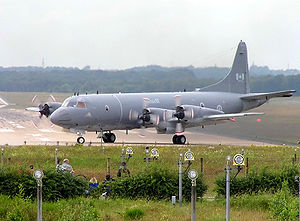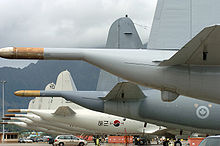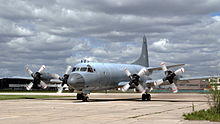- Lockheed CP-140 Aurora
-
CP-140 Aurora
CP-140A ArcturusCP-140 Aurora at Geilenkirchen AB, Germany Role Maritime patrol aircraft Manufacturer Lockheed First flight 22 March 1979 Introduction 1980 Status Active Primary user Royal Canadian Air Force Number built 21 (18 CP140 + 3 CP140A) Unit cost $24,905,000[1] Developed from Lockheed P-3 Orion The Lockheed CP-140 Aurora is a maritime patrol aircraft operated by the Royal Canadian Air Force. The aircraft is based on the Lockheed P-3 Orion airframe, but mounts the electronics suite of the S-3 Viking. In Greek mythology, Aurora is the Greek goddess who restored Orion's eyesight, and also the Aurora Borealis are the "northern lights" that are prominent over northern Canada and the Arctic Ocean.
The CP-140A Arcturus was a related variant used primarily for pilot training and coastal surface patrol missions.
Contents
Design and development
The CP-140 Aurora is very similar externally to the Lockheed P-3C Orion (Canadian ESM wingtip pods instead of the American ESM wing pod), but is different internally, using two sets of mission systems that were first installed in yet another Lockheed anti-submarine warfare aircraft, the carrier-based S-3A Viking. The aircraft's sensors are primarily intended for anti-submarine warfare (ASW) work but are also capable of maritime surveillance, counter-drug and search-and-rescue missions. The CP-140 is Canada's only strategic Intelligence Surveillance and Reconnaissance (ISR) aircraft, conducting long range missions over land, water and littoral areas. These missions are flown in support of CANCOM, CEFCOM, CANSOFCOM, the RCMP, and several other federal government departments.
In 1991, Lockheed shut down its production lines in Burbank, California for the P-3 Orion, which shares the same airframe with the CP-140. Three surplus airframes on hand were purchased by the Air Command, but delivered without the anti-submarine fit. These three aircraft were designated the CP-140A Arcturus and are used primarily for pilot training and coastal surface patrol missions.[2]
Aurora Incremental Modernization Project
The Aurora Incremental Modernization Project (AIMP), initiated in 1998 to upgrade electronics of the Aurora fleet was halted by the government on 20 September 2007 to evaluate whether the aging fleet should continue to be upgraded or replaced by more modern aircraft.[3] On 18 December 2007 the Department of National Defence rescinded this work suspension so that the project could continue. Work includes upgrading computer, navigation, communication and radar systems as well as making structural improvements to ten of eighteen aircraft. The intent of the modernization project is to "keep the aircraft safe and operationally viable until 2020.".[4]
AIMP is currently divided into three 'blocks". Block I is complete and concentrated on the replacement of unsupportable systems. Block II brought a glass cockpit with the Navigation and Flight Instruments (NFI) component provided by CMC Electronics,[5] and a complete replacement of the communications suite. Block II is nearing completion and should be complete in early 2011. Block III is a wholesale replacement of the aircraft's sensors and mission computer.
Aurora Structural Life Extension Program
The Aurora Structural Life Extension Project (ASLEP) is proceeding with 10 of the 18 Auroras scheduled to receive new wings and the replacement of key structural components. The complete ASLEP solution replaces the aircrafts' outer wings, center wing lower section and horizontal stabilizers with new production components. All fatigue-life limiting structures on the aircraft are replaced with enhanced-design components and improved corrosion-resistant materials that will greatly reduce maintenance costs over the aircraft's service life. This program is expected to extend the CP140s' service life by 15,000 flight hours per airframe.[6]
Operational history
CP-140 Aurora
The Aurora was acquired in the early 1980s to replace the CP-107 Argus and to further support Canada's anti-submarine warfare mission obligations under NATO for the northwest Atlantic sector.[7] Short deployments to Alaska (Adak), Hawaii (Kaneohe Bay), Iceland (Keflavik), the UK (St Mawgan and Kinloss), and Norway (Andoya) were the norm. However, since the end of the Cold War, they had been used primarily in coastal surveillance and sovereignty patrols by providing an all-weather mission surveillance platform. Increasingly as the CP-140 moves into the 21st century it is employed for domestic and international surveillance by CANCOM for security, counter-terrorism and smuggling, as well as to monitor foreign fishing fleets off Canada's coasts. CP-140s have also been deployed on operations such as Operation Assistance and Operation Apollo.
Deployments have included OP SHARPGUARD (Yugoslavia blockade), OP SIRIUS (Mediterranean Patrols), OP APOLLO (Persian Gulf region), and counter-narcotics patrols in the Gulf of Mexico and Pacific.[8] Through all this, patrols of the Canadian Arctic continue to take advantage of the airframe's unique abilities.[9]
Two CP-140 aircraft performed maritime patrol missions in the Libyan waters in order to help in the enforcement of the no-fly zone over Libya under Operation Odyssey Dawn and Operation Unified Protector.[10]
CP-140A Arcturus
Lacking the expensive, heavy and sensitive anti-submarine warfare as well as the anti-surface warfare fittings of the CP-140 Aurora, the Arcturus was more fuel efficient and was used for crew training duties (such as touch-and-go landing practice), general maritime surface reconnaissance (detecting drug operations, smuggling of illegal immigrants, fisheries protection patrols, pollution monitoring, etc.), search-and-rescue assistance and Arctic sovereignty patrols. The Arcturus did possess a superior AN/APS-507 surface search radar, incorporating modern functions such as track-while-scan that the Aurora's AN/APS-506 radar lacks but the Acturus did not have an integrated mission computer, or mission systems. It did, however, maintain the same military communications suite as the CP-140 Aurora.[citation needed]
All three aircraft were based at 14 Wing, one was used for technician training with the school on base CFB Greenwood, Nova Scotia. Two of the CP-140As were retired in 2011 when they were delivered to the Aerospace Maintenance and Regeneration Group (AMARG) in Tucson, Arizona.[11]
Replacement
Several options have been suggested for a CP-140 replacement. These include the Boeing P-8 Poseidon and the Raytheon Sentinel,[12][13] based on the Bombardier Global Express.[14]
Operators
- Royal Canadian Air Force
- 404 Maritime Patrol and Training Squadron, CFB Greenwood, Nova Scotia
- 405 Maritime Patrol Squadron, CFB Greenwood
- Maritime Proving and Evaluation Unit (MP&EU), CFB Greenwood
- 15 × CP-140 Aurora and 1 × CP-140A Arcturus
- 407 Long Range Patrol Squadron, CFB Comox, British Columbia
- 3 × CP-140 Aurora
Specifications (CP-140)
General characteristics
- Crew: Mission minimum 8, typically 12 to 15
- Capacity: 20
- Length: 35.61 m (116 ft 10 in)
- Wingspan: 30.38 m (99 ft 8 in)
- Height: 10.49 m (34 ft 5 in)
- Loaded weight: 27,892 kg (61,362 lb)
- Powerplant: 4 × Allison T-56-A-14-LFE turboprop engines, (4600 SHP) each
Performance
- Maximum speed: 750 km/h (405 kt, 462 mph)
- Range: 9,300 km (5,000 nm, 5,737 mi)
- Service ceiling: 10,700 m (35,100 ft)
Armament
- Mk 46 Mod V torpedoes, signal chargers, smoke markers, illumination flares
- air-to-surface rockets or conventional bombs can be fitted after a minor retrofit. Virtually any armament cleared for use on the P-3 series can be fitted for use based on airframe similarities.
Avionics
- Sonobuoys, Radar, Wescam MX-20 Electro-Optical/Infrared (EO/IR) suite, Magnetic anomaly detector (MAD), Electronic Support Measures (ESM), Applanix DSS-439 Digital Mapping Camera (DSS), hand-held digital camera, gyro-stabilized binoculars, 3 AN/ARC-210 V/UHF Radios, 1 AN/ARC-234 V/UHF SATCOM Radio.
See also
- Related development
- Aircraft of comparable role, configuration and era
- Avro Shackleton
- Breguet Atlantique
- Hawker-Siddeley Nimrod
- Ilyushin Il-38
- Related lists
References
- Notes
- ^ Cable, Ernie. Aurora Beginnings." CP-140 AURORA, 8 January 2011. Retrieved: 30 June 2011.
- ^ "Lockheed CP-140 Aurora." rcaf.com. Retrieved: 30 June 2011.
- ^ "Ottawa halts $1.6B upgrade of patrol aircraft." CBC.ca. Retrieved: 18 August 2010.
- ^ "CP-140 Aurora Modernization." Canadian Naval Review. Retrieved: 18 August 2010.
- ^ "Current Major Crown Projects." ic.gc.ca. Retrieved: 18 August 2010.
- ^ "Aurora." casr.ca. Retrieved: 18 August 2010.
- ^ Donald 1997, p. 118.
- ^ "CP-140 Aurora." airforce.forces.gc.ca. Retrieved: 18 August 2010.
- ^ "What we do: In Canada." airforce.forces.gc.ca. Retrieved: 18 August 2010.
- ^ "Canadian Forces Deploy Maritime Patrol Aircraft In Response To Situation In Libya." Canadian Forces website, 25 March 2011.
- ^ Nicholson, Pete (Sergeant). "The Final Flight of CP140/A AC120 to Tucson, Arizona." aviation.ca, 12 March 2011. Retrieved: 20 March 2011.
- ^ "Aurora Alternatives – Boeing P-8A Poseidon Project." Canadian American Strategic Review, 29 April 2009. Retrieved: 23 April 2011.
- ^ "Aurora Alternatives — Global Express / R1 Sentinel." Canadian American Strategic Review. Retrieved: 23 April 2011.
- ^ "Aurora Alternatives — Bombardier Global Express." Canadian American Strategic Review. Retrieved: 23 April 2011.
- Bibliography
- Donald, David. The Encyclopedia of World Aircraft. Etobicoke, Ontario: Prospero Books, 1997. ISBN 1-85605-375-X.
- Pickler, Ron and Milberry, Larry. Canadair: The First 50 Years. Toronto: CANAV Books, 1995. ISBN 0-921022-07-7.
- Winchester, Jim, ed. "Lockheed CP-140 Aurora." Modern Military Aircraft (Aviation Factfile). Rochester, Kent, UK: Grange Books plc, 2004. ISBN 1-84013-640-5.
External links
Lockheed and Lockheed Martin aircraft Manufacturer
designationsBasic Model
NumbersL-1 · L-2 · L-3 · L-4 · L-5 · L-7 · L-8 · L-9 · L-10 · L-11 · L-012 · (L-013 not assigned) · L-014 · L-015 · L-016 · L-017 · L-018 · L-019 · L-020 · L-021 · L-022 · L-023 · L-024 · (L-025 not assigned) · L-026 · L-027 · (L-028 not assigned) · L-029 · L-030 · L-031 · L-032 · L-033 · L-034 · L-035 · (L-036 not assigned) · L-037 · (L-038 and L-039 not assigned) · L-040 · L-041 · L-042 · L-044 · L-045 · L-049 · L-050 · L-051 · L-052 · L-060 · L-061 · L-062 · L-075 · L-080 · L-081 · L-082 · L-083 · L-084 · L-085 · L-086 · L-087 · L-088 · L-089 · L-090 · L-091 · L-092 · L-093 · L-094 · L-092 · L-099 · L-100 · L-133 · L-140 · L-141 · L-193 · L-245 · L-246 · L-300 · L-301 · L-329 · L-351 · L-382 · L-500 · L-645
Lockheed-California
Temporary Design
NumbersBy role Airliners and
civil transportsVega · Sirius · Altair · Orion · Electra · Electra Junior · Super Electra · Lodestar · Constellation (L-049 · L-649 · L-749) · Super Constellation (L-1049 · L-1249) · Starliner · Saturn · Electra · L-402 · JetStar · L-100 · L-1011
Military transportsY1C-12 · Y1C-17 · Y1C-23 · Y1C-25 · C-36 · C-37 · C-40 · C-56 · C-57 · C-59 · C-60 · C-63 · C-66 · C-69 · UC-85 · UC-101 · C-104 · C-111 · C-121 · C-130 / C-130J / HC-130 / KC-130 / LC-130 / MC-130 · C-139 · C-140 · C-141 · C-5 · JO · XRO · R2O · R3O · XR4O · R5O · R6O / R6V · R7O / R7V · R8V / GV / UV · TriStar
Attack and bombersDrones/UAVsEW and
reconnaissanceFightersHelicoptersMaritime patrolTrainersExperimentalNames Air Express · Aquila · Altair · Aurora · Big Dipper · Blackbird · Chain Lightning · Cheyenne · Constellation (L-049 · L-649 · L-749) · Constitution · Electra (Model 10) · Electra (Model 88) · Electra Junior · Excalibur · Explorer · Fighting Falcon · Galaxy · Have Blue · Hercules · Hudson · Hummingbird · JetStar · Kestrel · Kingfisher · Lightning · Lightning II · Little Dipper · Lodestar · Neptune · Orion (Model 9) · Orion (P-3) · Polecat · Raptor · Saturn · SeaStar · Sentinel · Shooting Star · Sirius · Starfighter · Starfire · Starlifter · Starliner · Super Constellation (L-1049 · L-1249) · Super Electra · Super Galaxy · Super Hercules · Tristar · Vega · Ventura · Viking · Warning Star
Canadian Forces unified aircraft designations post-1968 100-125 126–150 151- Lists relating to aviation General Aircraft (manufacturers) · Aircraft engines (manufacturers) · Airlines (defunct) · Airports · Civil authorities · Museums · Registration prefixes · Rotorcraft (manufacturers) · TimelineMilitary Accidents/incidents Records Categories:- Lockheed aircraft
- Signals intelligence
- United States patrol aircraft 1970–1979
- Royal Canadian Air Force
Wikimedia Foundation. 2010.



